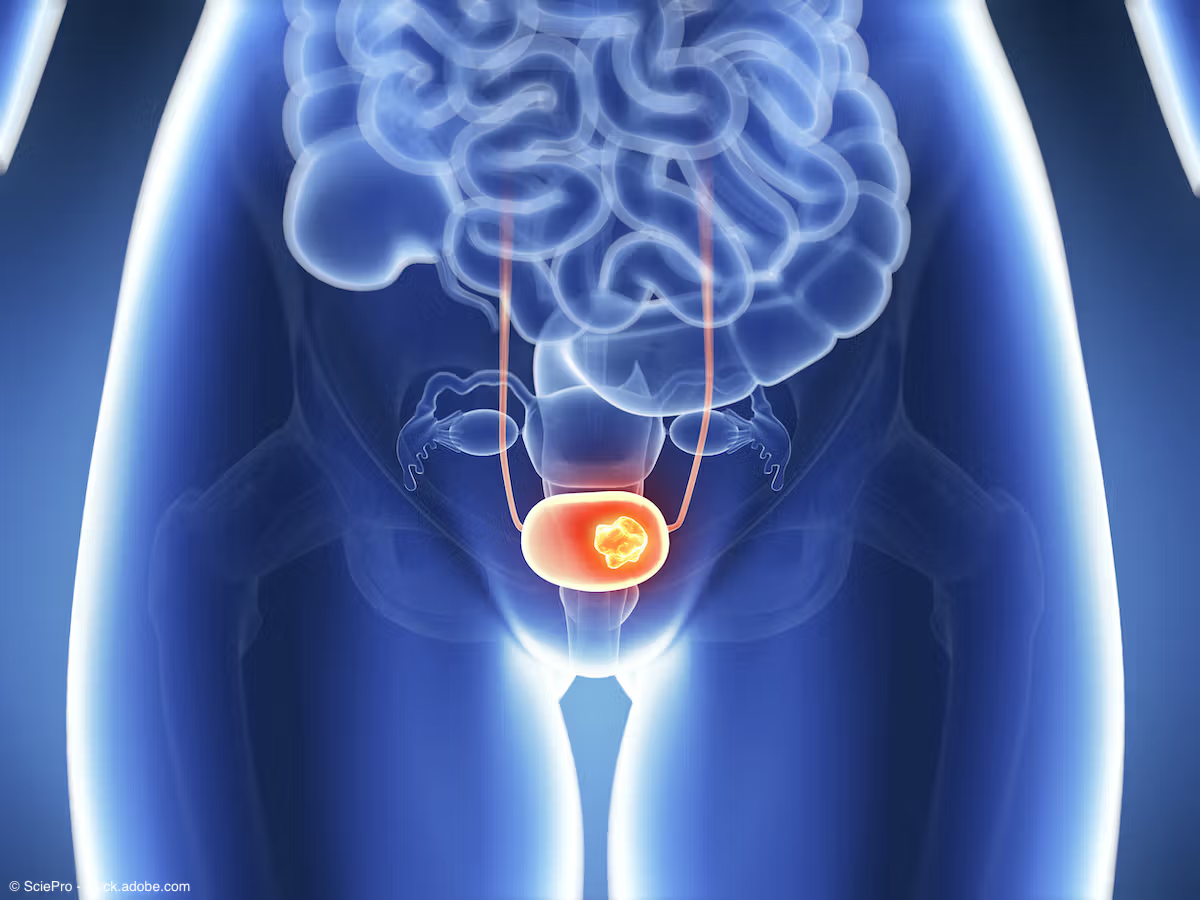Feature
Article
Biomarker may predict MIBC status following neoadjuvant chemo
Author(s):
Key Takeaways
- A 4-gene signature (ATM, RB1, FANCC, ERCC2) correlates with tumor absence post-neoadjuvant chemotherapy in muscle-invasive bladder cancer.
- The biomarker is more effective at predicting disease presence, influencing surgical decisions in clinical trials like RETAIN.
"The biomarker is better at predicting presence of disease than absence, and the reason that that's important is that's how we can think about the biomarker aiding in careful clinical assessment of patients," says Elizabeth R. Plimack, MD, MS, FASCO.
Elizabeth R. Plimack, MD, MS, FASCO

In this interview, Elizabeth R. Plimack, MD, MS, FASCO, discusses the recent European Urology paper, “Correlative Analysis of ATM, RB1, ERCC2, and FANCC Mutations and Pathologic Complete Response After Neoadjuvant Chemotherapy in Patients with Muscle-invasive Bladder Cancer: Results from the SWOG S1314 Trial.” Plimack is deputy director of Fox Chase Cancer Center and professor of hematology and oncology at Fox Chase Cancer Center in Philadelphia, Pennsylvania.
Please describe the background for this study as well as its notable findings.
Back in 2013 we completed a small, single-arm clinical trial of dose-dense MVAC followed by cystectomy for patients with muscle-invasive bladder cancer. As part of that study, we learned that 38% of patients had no viable tumor in their bladder at the time of surgery. We then took all the biopsies we collected from patients pre chemotherapy, biopsies that were collected from the bladder through a procedure called TURBT [transurethral resection of bladder tumor], and we analyzed these samples using a commercially available panel test looking for genes within the tumor that were mutated. It was very novel at the time; that was before we were using this routinely in clinical care for bladder and other cancers. We got a big data set that we were able to then correlate mutations with the presence or absence of disease at surgery. With the help of our statistician here, Eric Ross, instead of just looking at individual genes correlations with outcomes we looked at combinations of different genes that might correlate.
Using this decision tree analysis, we came up with a 3-gene signature: ATM, RB1, and FANCC – patients with any one of these mutations had a high likelihood of having no tumor in their bladder at surgery. We validated our findings on a separate, single-arm trial chemotherapy (Dose Dense Gem Cis), and found that they validated.Through further study and collaboration with the team at Memorial Sloan Kettering Cancer Center and Dana-Farber Cancer Institute, we added a fourth gene that was found to correlate, ERCC2. What we had yet to do before we did this research: a truly separate data set of external samples for external validation, and we got the opportunity by getting access to samples collected on the SWOG S1314 trial. This trial was looking at a different set of biomarkers to correlate with complete response, the COXEN algorithm. The COXEN algorithm did not ultimately pan out to meet the end points set forth by the trial, but the trial produced a valuable set of DNA samples collected before chemotherapy which in context of the clinical data collected on surgical outcomes, we could analyze in the same way we analyzed our prior samples.
Using these 105 samples, we tested our 4-gene signature, and we confirmed that having a mutation in any one of those genes correlated with the probability of having a clean bladder at surgery. The was highly statistically significant: The p value was .0006, with an odds ratio of 5.36. We also found that if you had more than one of these mutations, you were even more likely to have a clean bladder, and so we took this as a validation of our prior findings.
The abstract mentions that the biomarker is better at predicting the presence rather than the absence of disease. How does this finding affect clinical decision-making, and what are the potential implications for patient management?
The biomarker is better at predicting presence of disease than absence, and the reason that that's important is that's how we can think about the biomarker aiding in careful clinical assessment of patients. One potential use of this biomarker is to say, if we know your bladder is going to be clean, maybe we don't have to remove it at all. Maybe we can keep it in place. But it's not 100%; we don't know for sure. The fact that the biomarker is better at defining presence of disease than absence means that when we use this in clinical trials (and we have used this in clinical trials such as RETAIN and RETAIN II) to take people who appear to have clean bladders on cystoscopy with biopsy and imaging and say, "If you don't have a mutation, we think your bladder is not actually clean, that there's cancer hiding there, and we're going to route you to cystectomy." The biomarker is not as good at taking a patient who appears to be clean on cystoscopy, biopsy, and imaging and allowing us to say "We are extra sure that there's no cancer in your bladder." So in the context of the RETAIN trials it only serves to take the pool of people with clinical complete response after a chemotherapy, meaning we don't see anything in the bladder, and blind biopsies don't find anything, and imaging doesn't find anything and then pull some people out of that group and say, "We think this biomarker is telling us that there's disease hiding somewhere. We don't think it's okay for you to keep your bladder, we're going to route you to surgery.”
So in a way, if someone has a mutation, it's good. It means you probably have a clean bladder. But if someone doesn't have a mutation, we say, "You're probably someone that really needs surgery," and we feel a little bit better about that surgical decision. Again, all this is being tested in the context of clinical trials like RETAIN and RETAIN II and those results will help inform how useful it is in practice. There are other trials like it that are ongoing, looking to cure patients with systemic therapy alone. No combination of clinical or biologic biomarkers will parse everyone, exactly—those who have cancer and those that don't—but the biomarker we tested in this study did validate what we had seen before in terms of the correlation. So it's not a fluke. It is real, but its utility is defined by the operating characteristics of the test in combination with careful clinical assessment of the bladder after neoadjuvant chemotherapy, if you're looking to take on an active surveillance approach.
How do you envision this biomarker being integrated into a clinical workflow to inform patient selection for bladder preservation and what additional clinical factors should be considered in conjunction with the biomarker?
This biomarker should never be used by itself. We should still use all our clinical assessments including imaging and cystoscopy and biopsy. Obviously, if you look in the bladder and you do biopsies and you see cancer there, that's the gold standard. No one's going to argue with that. It doesn't matter what the biomarker says. Right now, outside of a clinical trial, I don't recommend using this, but there are patients who say, "I really want to keep my bladder." This could be used similarly to how we're using ctDNA to inform adjuvant decisions. It’s not definitive, but it could be a clue. For the patient who wants to keep their bladder after chemotherapy who says, "Do I really need surgery?" one could order this test. If it has a mutation, you're a little more confident keeping their bladder in and watching them if they truly refuse cystectomy. If it doesn't have a mutation, you're more confident in your recommendation that the bladder should really be removed for cure.
What are some next steps for this research? Do you have plans to investigate the role of these mutations in other stages of bladder cancer or in response to different treatment modalities?
That's a really good question. I think when we do NGS [next-generation sequencing] on patients who are just starting platinum-based therapy in the metastatic setting, and there is an ERCC2 mutation or RB1 mutation, we might allow ourselves to be a little more optimistic and believe "Chemo will probably work for you," but we have not tested it in that space. So that would just be pure extrapolation from the neoadjuvant space to use it there. I do think these biomarkers are specific to platinum-based therapy. We did try it with MVAC and Gem Cis [gemcitabine-cisplatin] in both our discovery cohorts and in the COXEN trial that we're reporting on now. I don't think the exact regimen matters, but cisplatin is common to both of those. I would not advocate using this after some sort of novel neoadjuvant treatment, like if we move to EV Pembro [enfortumab-vedotin-ejfv -pembrolizumamb] or neoadjuvant immunotherapy, I would not lean on these to be as predictive in that space, because they've only been tested in the setting of platinum-based neoadjuvant chemotherapy.
We've done as much validation of this particular biomarker as we can. It's not perfect. It should not be used without clinical assessment.
I will say these all 3 genes in the signature are DNA damage repair genes, and so it makes sense that that having a deleterious alteration in one of these would make a tumor sensitive to something like platinum, just a DNA damaging agent. So there's some mechanistic support for this, but we haven't done the mechanistic studies to directly prove that. It’s nice to see a link between the function of the gene and our findings.
Newsletter
Stay current with the latest urology news and practice-changing insights — sign up now for the essential updates every urologist needs.













